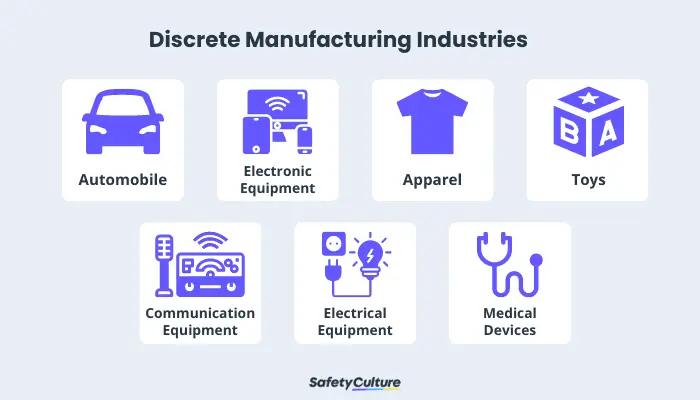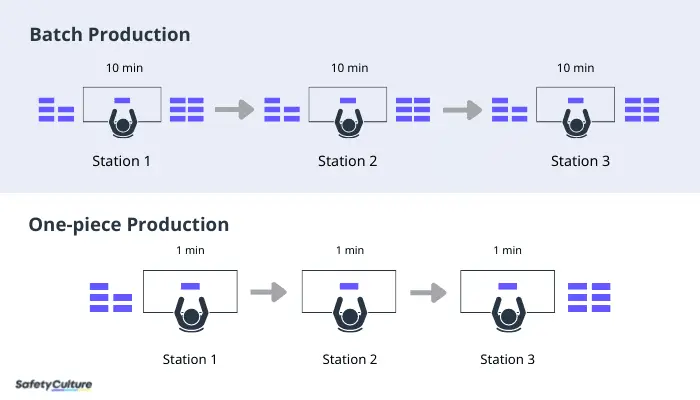What is One Piece Flow?
One piece flow, sometimes referred to as “continuous flow” or “single-piece flow,” is a discrete production method used in lean manufacturing that is closely associated with the Just-in-Time system—a key concept within the Toyota Production System. One piece flow is also one of the most important factors to consider when it comes to developing a lean environment.
It is closely associated with the Just-in-Time system because manufactured goods go through a continuous flow of steps with no Work-in-Process (WIP) or downtime. In a one piece flow setup, workstations are arranged in a way where production can flow continuously—one at a time through each step of the process—from setup until completion.
Cellular Layout
The most efficient strategy for higher efficiency is to use one piece flow in combination with a cellular layout, wherein all necessary equipment is located in a single area during the cycle of operations. This is simply laying out or setting up all necessary materials or machineries according to the order of their workflow.
Discrete Flow of Work
One piece flow is also closely related to discrete manufacturing. Discrete manufacturing is the production of distinct items like cars, furniture, electronics (e.g. smartphones and computers) and airplanes. Discrete means “individually separate and distinct,” implying that the product can have different characteristics or can be added with other features as demanded during the process.

Discrete Manufacturing Industries source: Erp-information
Erp-information.com defined it as “a process that produces products in individual, separate pieces” and “a process of production that involves making one product at a time.” According to JD Edwards World Product Data Management in their Discrete Guide, discrete manufacturing supports the following strategies:
- Make-to-stock,
- Any of the to-orders, including:
- Make-to-order
- Assemble-to-order
- Engineer-to-order
- Job shop production—there are several specific workstations or workshops for this type of manufacturing process.
One Piece Flow vs Batch Production Flow
There are a lot of sources and experiments where one piece flow is compared with the batch production process. Unlike in one piece flow where each item go one at a time through each step, batch production is a method wherein goods or items are produced by batch, in bulk, or en masse. The goods in batch production have to be finished first before it can be moved to another step. See illustration below:

Batch Production vs One-piece Production source: nikunjbhoraniya
When materials move through the manufacturing process in batches, it can be inefficient. There are additional steps which add to production time. In one piece flow, a product is completed first before beginning with the next item.
Digitize the way you Work
Empower your team with SafetyCulture to perform checks, train staff, report issues, and automate tasks with our digital platform.
Get Started for FreeAdvantages
One piece flow has a number of major advantages compared to batch production flow, particularly in terms of waste reduction, manufacturing time reduction, and better process efficiencies. More about its advantages are listed below:
- Shorter production time—it reduces the time needed for completion because there is reduced WIP and no downtime. When there is a shorter processing time, expenses required for production are automatically reduced. Additionally, when the production time is reduced, manufacturing companies can be more flexible in responding to demands or changes required by customers.
- Less inventory—it reduces the need for floor space or warehouse space for stocks because companies are only producing what is needed or ordered from them.
- Faster detection of errors or defects—it is easier to spot defects in the one piece flow system because manufacturing is focused on one product at a time. If a problem is detected, the only affected product will be the one in the current process. Whereas, defects in a batch production can affect the entire batch or more before they are noticed. When detection is faster, corrective action can be taken quickly to ensure the problem won’t reoccur and affect the other items.
- Improved lead times—it helps in getting the products reach your customers faster, boosting customer satisfaction.
- Better product quality—it becomes much easier for a manufacturer to make quality products. This is because each operator doubles up as a quality control inspector and can fix problems they encounter at their work station before moving the item to the next step in production.
- Reduced waste—it minimizes the occurrence of deadly waste because one piece flow prevents overproduction, whereas all unsaleable items from batch production contribute to a myriad of waste—inventory waste, waste in labor, waste in capital, and time wasted.
- Safer work environment—it makes the workplace safer because clutter is lessened when one piece flow is implemented, minimizing the risk of work-related injuries.
- Improved workers’ morale—it encourages employee engagement and involvement in problem-solving, making the workplace conducive to proactively catching issues.



